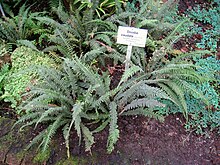
Thelypteridaceae is a family of about 900 species of ferns in the order Polypodiales. In the Pteridophyte Phylogeny Group classification of 2016, it is placed in the suborder Aspleniineae. Alternatively, the family may be submerged in a very broadly defined family Aspleniaceae as the subfamily Thelypteridoideae.
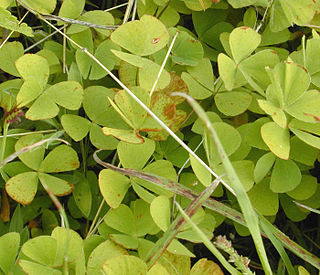
The order Salviniales is an order of ferns in the class Polypodiopsida.

The Dryopteridaceae are a family of leptosporangiate ferns in the order Polypodiales. They are known colloquially as the wood ferns. In the Pteridophyte Phylogeny Group classification of 2016 (PPG I), the family is placed in the suborder Polypodiineae. Alternatively, it may be treated as the subfamily Dryopteridoideae of a very broadly defined family Polypodiaceae sensu lato.
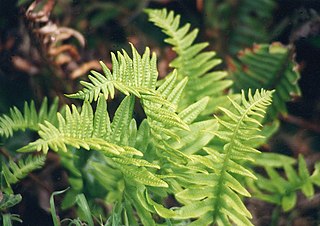
The order Polypodiales encompasses the major lineages of polypod ferns, which comprise more than 80% of today's fern species. They are found in many parts of the world including tropical, semitropical and temperate areas.

Polypodiaceae is a family of ferns. In the Pteridophyte Phylogeny Group classification of 2016, the family includes around 65 genera and an estimated 1,650 species and is placed in the order Polypodiales, suborder Polypodiineae. A broader circumscription has also been used, in which the family includes other families kept separate in PPG I. Nearly all species are epiphytes, but some are terrestrial.

Blechnaceae is a family of ferns in the order Polypodiales, with a cosmopolitan distribution. Its status as a family and the number of genera included have both varied considerably. In the Pteridophyte Phylogeny Group classification of 2016, the family has 24 genera, and excludes genera placed in the separate family Onocleaceae. The family is divided into three subfamilies, including Blechnoideae s.s. Alternatively, the entire family may be treated as the subfamily Blechnoideae s.l. of a very broadly defined family Aspleniaceae, and include genera others place in Onocleaceae.
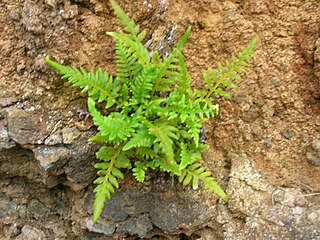
Pteridaceae is a family of ferns in the order Polypodiales, including some 1150 known species in ca 45 genera, divided over five subfamilies. The family includes four groups of genera that are sometimes recognized as separate families: the adiantoid, cheilanthoid, pteridoid, and hemionitidoid ferns. Relationships among these groups remain unclear, and although some recent genetic analyses of the Pteridales suggest that neither the family Pteridaceae nor the major groups within it are all monophyletic, as yet these analyses are insufficiently comprehensive and robust to provide good support for a revision of the order at the family level.

Woodwardia is a genus of ferns in the family Blechnaceae, in the suborder Aspleniineae of the order Polypodiales. Species are known as netted-chain ferns. The genus is native to warm temperate and subtropical regions of the Northern Hemisphere. They are large ferns, with fronds growing to 50–300 cm long depending on the species. The fossil record of the genus extends to the Paleocene.

Woodsiaceae is a family of ferns. In the Pteridophyte Phylogeny Group classification of 2016 (PPG I), it is placed in the suborder Aspleniineae. The family can also be treated as the subfamily Woodsioideae of a very broadly defined family Aspleniaceae sensu lato. In PPG I, the family contained only one genus, Woodsia. In 2020, Physematium was split off from Woodsia on the basis of molecular phylogenetic evidence. As of June 2023, Plants of the World Online continued to treat Physematium as a synonym of Woodsia.

The Lomariopsidaceae is a family of ferns with a largely tropical distribution. In the Pteridophyte Phylogeny Group classification of 2016 (PPG I), the family is placed in the suborder Polypodiineae of the order Polypodiales. Alternatively, it may be treated as the subfamily Lomariopsidoideae of a very broadly defined family Polypodiaceae sensu lato.
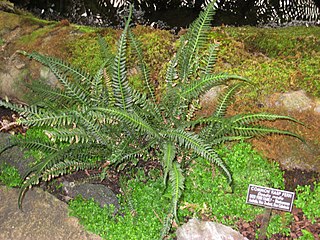
Doodia media, also known as rasp fern, is a fern species in the family Blechnaceae. The species was formally described by botanist Robert Brown in 1810. Distribution of the species includes New Zealand's North Island and the upper part of the South Island. It is also found in Australia and Lord Howe Island.

Diplazium is a genus of ferns that specifically includes the approximately 400 known species of twinsorus ferns. The Greek root is diplazein meaning double: the indusia in this genus lie on both sides of the vein. These ferns were earlier considered part of either the Athyriaceae, Dryopteridaceae, Aspleniaceae, or Polypodiaceae families or recognized as belonging to their own taxonomic family. The Pteridophyte Phylogeny Group classification of 2016 places the genus in the Athyriaceae. The taxonomy of the genus is difficult and poorly known, and by 2009 has never been the subject of a complete monographic study. Their distribution is pantropical, with a few species extending into temperate areas.

Cystopteridaceae is a family of ferns in the order Polypodiales. In the Pteridophyte Phylogeny Group classification of 2016 (PPG I), the family is placed in the suborder Aspleniineae of the order Polypodiales, and includes three genera. Alternatively, it may be treated as the subfamily Cystopteridoideae of a very broadly defined family Aspleniaceae.

Grammitidoideae is a subfamily of the fern family Polypodiaceae, whose members are informally known as grammitids. It comprises a clade of about 750 species. They are distributed over higher elevations in both the Old and New World. This group was previously treated as a separate family, Grammitidaceae until molecular phylogenies showed it to be nested within the Polypodiaceae. It has since been treated as an unranked clade within subfamily Polypodioideae, and, most recently, as a separate subfamily.
Hemidictyum is a genus of ferns with a single species, Hemidictyum marginatum, commonly known as the marginated half net fern. In the Pteridophyte Phylogeny Group classification of 2016, it is the only genus in the family Hemidictyaceae. Alternatively, the family, along with Aspleniaceae sensu stricto, may be placed in a much more broadly defined family Aspleniaceae as the subfamily Asplenioideae.

Diplaziopsidaceae is a family of ferns in the order Polypodiales. In the Pteridophyte Phylogeny Group classification of 2016 (PPG I), the family is placed in the suborder Aspleniineae, and includes two genera. Alternatively, it may be treated as the subfamily Diplaziopsidoideae of a very broadly defined family Aspleniaceae.
Rhachidosorus is a genus of ferns in the order Polypodiales. It is the only genus in the family Rhachidosoraceae in the Pteridophyte Phylogeny Group classification of 2016. Alternatively, the genus may be placed in the subfamily Rhachidosoroideae of a more broadly defined family Aspleniaceae, the family placement used in Plants of the World Online as of November 2019.
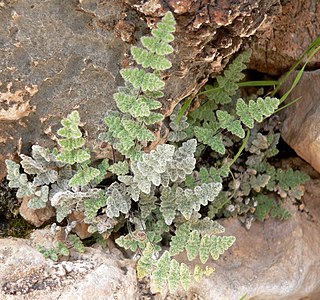
Cheilanthoideae is one of the five subfamilies of the fern family Pteridaceae. The subfamily is thought to be monophyletic, but some of the genera into which it has been divided are not, and the taxonomic status of many of its genera and species remains uncertain, with radically different approaches in use as of December 2019.

Doryopteris is a genus of ferns in the subfamily Cheilanthoideae of the family Pteridaceae.

Doodia maxima, also known as the giant rasp fern, occurs in moist open forests in eastern Australia. It was considered to be a natural hybrid. Some sources place the species in the genus Blechnum, others, including the Pteridophyte Phylogeny Group classification of 2016, place it in Doodia.
